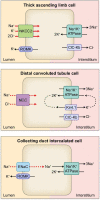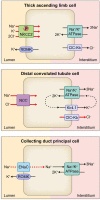Kidney and blood pressure regulation-latest evidence for molecular mechanisms
- PMID: 37261007
- PMCID: PMC10229285
- DOI: 10.1093/ckj/sfad015
Kidney and blood pressure regulation-latest evidence for molecular mechanisms
Abstract
Hypertension is one of the major health problems leading to the development of cardiovascular diseases. Despite a rapid expansion in global hypertension prevalence, molecular mechanisms leading to hypertension are not fully understood largely due to the complexity of pathogenesis involving several factors. Salt intake is recognized as a leading determinant of blood pressure, since reduced dietary salt intake is related to lower morbidity and mortality, and hypertension in relation to cardiovascular events. Compared with salt-resistant populations, salt-sensitive individuals exhibit high sensitivity in blood pressure responses according to changes in salt intake. In this setting, the kidney plays a major role in the maintenance of blood pressure under the hormonal control of the renin-angiotensin-aldosterone system. In the present review, we summarize the current overview on the molecular mechanisms for modulation of blood pressure associated with renal ion channels/transporters including sodium-hydrogen exchanger isoform 3 (NHE3), Na+-K+-2Cl- cotransporter (NKCC2), sodium-chloride cotransporter (NCC), epithelial sodium channel (ENaC) and pendrin expressed in different nephron segments. In particular, recent studies on experimental animal models with deletion of renal ion channels led to the identification of several crucial physiological mechanisms and molecules involved in hypertension. These findings could further provide a potential for novel therapeutic approaches applicable on human patients with hypertension.
Keywords: blood pressure regulation; hypertension; renal salt transport; renin–angiotensin–aldosterone system (RAAS).
© The Author(s) 2023. Published by Oxford University Press on behalf of the ERA.
Conflict of interest statement
The authors have no conflicts of interest to declare.
Figures




Similar articles
-
SGLT2 inhibition effect on salt-induced hypertension, RAAS, and Na+ transport in Dahl SS rats.Am J Physiol Renal Physiol. 2022 Jun 1;322(6):F692-F707. doi: 10.1152/ajprenal.00053.2022. Epub 2022 Apr 25. Am J Physiol Renal Physiol. 2022. PMID: 35466690 Free PMC article.
-
Renal sodium transport in renin-deficient Dahl salt-sensitive rats.J Renin Angiotensin Aldosterone Syst. 2016 Jul 21;17(3):1470320316653858. doi: 10.1177/1470320316653858. Print 2016 Jul. J Renin Angiotensin Aldosterone Syst. 2016. PMID: 27443990 Free PMC article.
-
Upregulation of apical sodium-chloride cotransporter and basolateral chloride channels is responsible for the maintenance of salt-sensitive hypertension.Am J Physiol Renal Physiol. 2008 Aug;295(2):F556-67. doi: 10.1152/ajprenal.00340.2007. Epub 2008 May 14. Am J Physiol Renal Physiol. 2008. PMID: 18480177
-
NEDD4-2 and salt-sensitive hypertension.Curr Opin Nephrol Hypertens. 2015 Mar;24(2):111-6. doi: 10.1097/MNH.0000000000000097. Curr Opin Nephrol Hypertens. 2015. PMID: 25602517 Review.
-
Impact of Salt Intake on the Pathogenesis and Treatment of Hypertension.Adv Exp Med Biol. 2017;956:61-84. doi: 10.1007/5584_2016_147. Adv Exp Med Biol. 2017. PMID: 27757935 Review.
Cited by
-
Chromatin State Maps of Blood Pressure-Relevant Renal Segments Reveal Potential Regulatory Role for SNPs.Hypertension. 2025 Mar;82(3):476-488. doi: 10.1161/HYPERTENSIONAHA.124.23873. Epub 2024 Dec 26. Hypertension. 2025. PMID: 39723540
-
Transport and thiazide-inhibition mechanisms of the Na-Cl cotransporter: a structural perspective.Curr Opin Nephrol Hypertens. 2025 Sep 1;34(5):440-449. doi: 10.1097/MNH.0000000000001099. Epub 2025 Jul 3. Curr Opin Nephrol Hypertens. 2025. PMID: 40575829 Free PMC article. Review.
-
Peripheral Blood miRNA Expression in Patients with Essential Hypertension in the Han Chinese Population in Hefei, China.Biochem Genet. 2025 Aug;63(4):3170-3186. doi: 10.1007/s10528-024-10867-6. Epub 2024 Jun 21. Biochem Genet. 2025. PMID: 38907084 Free PMC article.
-
Renal Inflammation, Oxidative Stress, and Metabolic Abnormalities During the Initial Stages of Hypertension in Spontaneously Hypertensive Rats.Cells. 2024 Oct 25;13(21):1771. doi: 10.3390/cells13211771. Cells. 2024. PMID: 39513878 Free PMC article.
-
Aldosterone Synthase Inhibitors for Cardiorenal Protection: Ready for Prime Time?Kidney Blood Press Res. 2024;49(1):1041-1056. doi: 10.1159/000542621. Epub 2024 Nov 18. Kidney Blood Press Res. 2024. PMID: 39557029 Free PMC article. Review.
References
-
- Whelton PK, He J, Appel LJet al. . Primary prevention of hypertension: clinical and public health advisory from the National High Blood Pressure Education Program. J Am Med Assoc 2002;288:1882–8. - PubMed
-
- Whelton PK, He J. Health effects of sodium and potassium in humans. Curr Opin Lipidol 2014;25:75–9. - PubMed
Publication types
LinkOut - more resources
Full Text Sources

